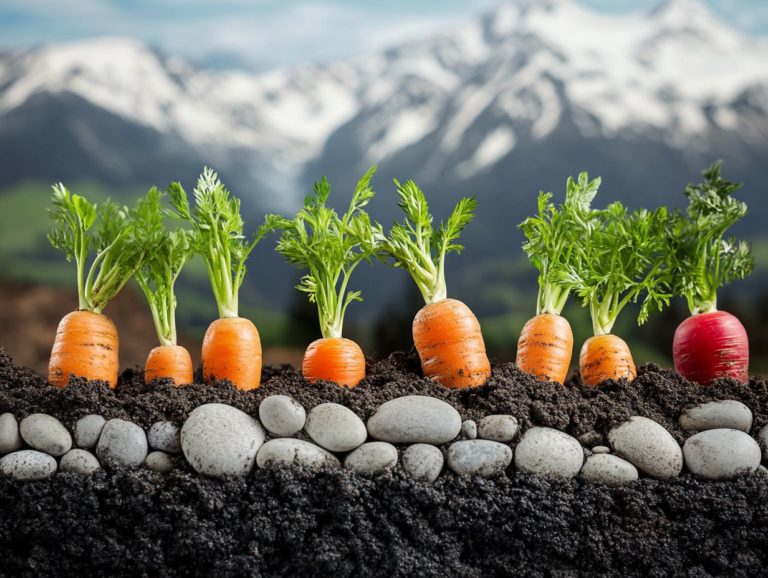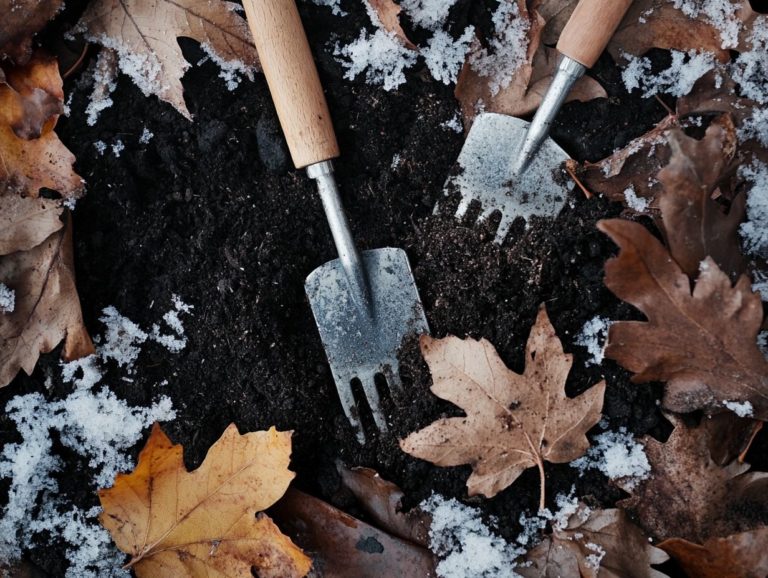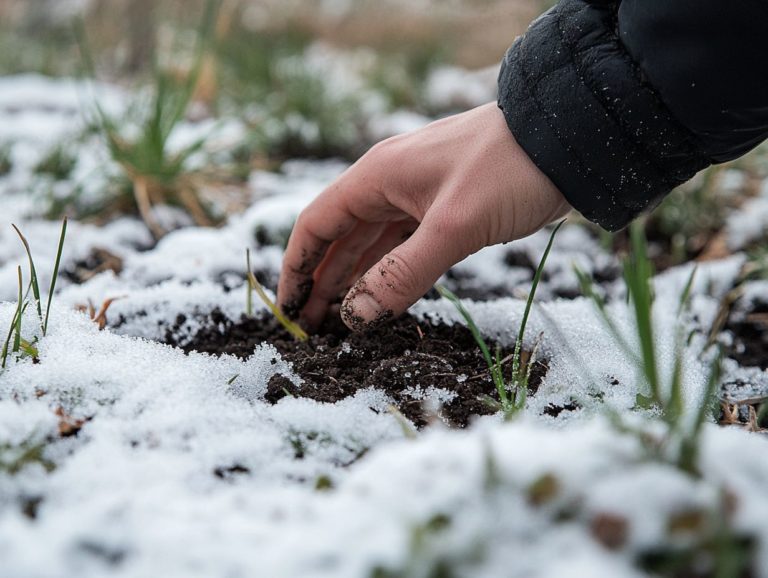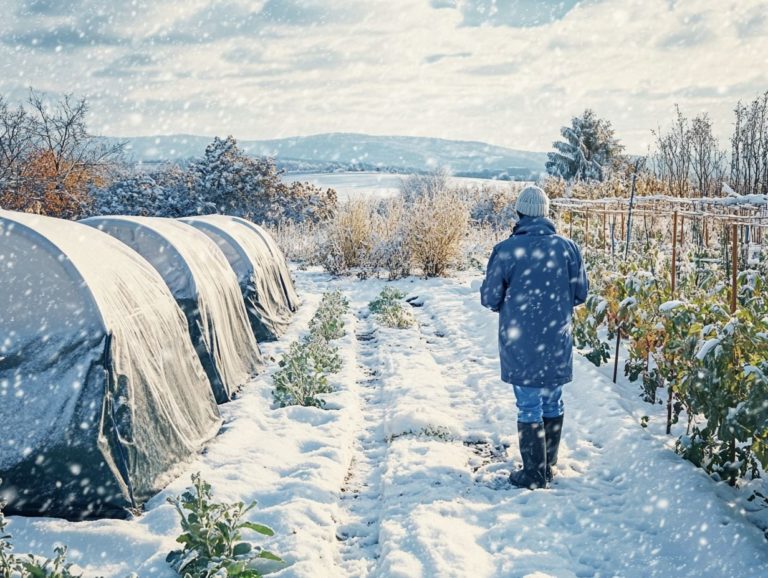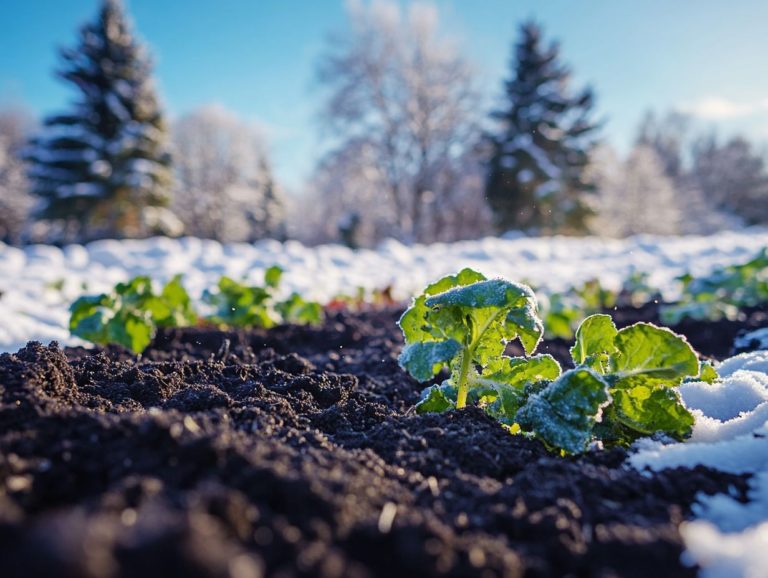The Best Cover Crops for Cold-Climate Gardens
In cold-climate gardening, selecting the right winter cover crops can truly transform your gardening experience! These green allies not only enhance soil fertility and health but also protect against erosion, suppress weeds, and improve moisture retention.
From the robust winter rye to the vibrant crimson clover, each crop presents unique benefits that cater to the challenges posed by cooler growing seasons. This article delves into the top cover crops benefits for cold climates, guiding you in choosing the perfect fit for your garden s specific needs.
Continue reading to uncover how you can elevate your soil’s vitality and resilience!
Contents
- Key Takeaways:
- 1. Benefits of Cover Crops in Cold-Climate Gardens
- 2. Winter Rye
- 3. Winter Wheat
- 4. Crimson Clover
- 5. Hairy Vetch
- 6. Austrian Winter Peas
- 7. Oats
- 8. Winter Barley
- 9. Buckwheat
- 10. Field Peas
- 11. Red Clover
- 12. Alfalfa
- 13. Winter Triticale
- 14. Fava Beans
- 15. Mustard
- How to Choose the Right Cover Crop for Your Cold-Climate Garden?
- Frequently Asked Questions
- What are cover crops and why are they important for cold-climate gardens?
- What are the best cover crops for cold-climate gardens?
- How do I plant cover crops in my cold-climate garden?
- What are the benefits of using cover crops in a cold-climate garden?
- Do cover crops need to be fertilized in cold-climate gardens?
- When should I terminate my cover crops in a cold-climate garden?
Key Takeaways:
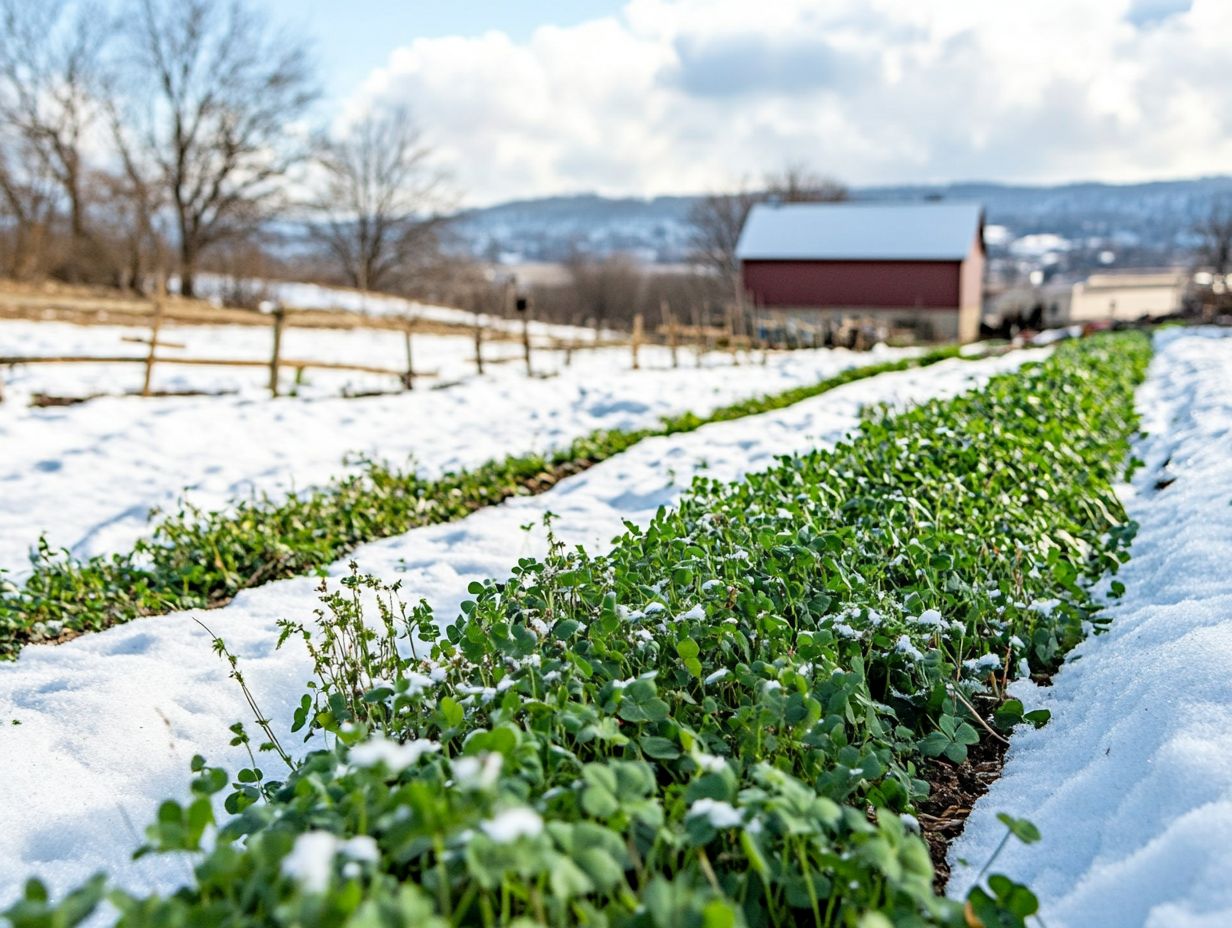
- Protect your soil with winter rye for organic matter!
- Boost your garden’s fertility with hairy vetch!
- Control pests and diseases with mustard, making it a great option for fall or early spring planting!
1. Benefits of Cover Crops in Cold-Climate Gardens
Cover crops, especially the winter varieties, are essential for enhancing soil fertility and the overall health of your cold-climate garden. To ensure you’re using the right approach, it’s important to consider what is the best soil for cold-climate gardens. They also prevent soil erosion and boost organic matter content.
By incorporating winter cover crops like hairy vetch, crimson clover, and winter rye, you can enjoy natural weed suppression while nurturing an ecosystem that supports natural plant growth.
These crops not only shield your soil from winter’s harsh realities but also significantly help produce natural plant material and improve soil health. For those interested in maximizing their winter garden, consider exploring vegetables that thrive in cold weather. This enriches the nutrient profile and promotes sustainable gardening practices that pave the way for long-term agricultural success.
Winter cover crops can also work wonders for your soil texture, making it more friable and easier to manage come springtime. Take winter rye, for example its extensive root system enhances soil aeration, allowing for better water infiltration and reducing compaction, which is particularly crucial in cold climates.
Hairy vetch is also excellent for contributing organic matter. It breaks down faster than other crops, providing readily available nutrients for the following planting season.
Selecting a well-balanced mix of cover crops tailored to your local conditions and desired benefits bolsters soil health and cultivates resilience against pests and diseases, ensuring your garden ecosystem thrives.
2. Winter Rye
Winter rye stands out as a resilient cover crop, celebrated for its impressive ability to enhance soil fertility and prevent erosion. It’s no wonder that gardeners in colder regions favor it, especially when combined with the top 10 soil amendments for cold-weather gardens!
This remarkable crop boasts several traits that contribute to its winter-hardiness. Its deep root system anchors the soil effectively, while its impressive tolerance to freezing temperatures ensures it can withstand harsh conditions. Winter rye excels in producing a significant amount of green matter that you can easily incorporate back into the soil.
This process not only improves soil structure but also boosts nutrient availability, fostering healthier plant growth in the following seasons. Aim to plant it in late summer or early fall for optimal results.
Couple this with diligent management practices, such as regularly checking for pests or diseases, and you ll set the stage for this hardy crop to thrive, benefiting both your garden and the surrounding ecosystem.
3. Winter Wheat
Winter wheat stands out as an exceptional cover crop, playing a vital role in enhancing soil fertility and significantly preventing erosion, especially in regions that endure harsh winter conditions. This makes it a preferred choice for vegetable gardens.
It flourishes in cooler temperatures and boasts an extensive root system that enriches soil structure. It also boosts organic matter essential elements for maintaining overall soil health. Winter wheat produces impressive biomass. This provides valuable organic material for future crops.
Winter wheat is compatible with other cover crops, such as clover and radish, fostering biodiversity and nurturing beneficial soil microbiomes. Ultimately, it contributes to enhanced agricultural sustainability.
4. Crimson Clover
Crimson clover, a standout nitrogen-fixing legume, is renowned for its remarkable ability to enhance soil fertility while effectively suppressing weeds. This makes it an invaluable asset for your cold-climate garden.
This striking cover crop grows with vigor, often reaching heights of 12 to 24 inches, offering both visual allure and practical benefits. It elevates nitrogen levels in the soil and fosters healthier microbial activity, crafting a balanced ecosystem for your diverse plants. The lush blossoms of crimson clover act as a powerful magnet for beneficial insects like bees and ladybugs, which play essential roles in pollination and pest control.
Don t miss out! Sow this enchanting clover in late summer or early spring for vibrant growth. By maintaining a moderate moisture level and mowing regularly, you can prevent the plants from becoming overly lush, allowing them to fully realize their soil-enriching potential.
5. Hairy Vetch
Hairy vetch is an amazing cover crop that brings versatility to your garden! It is renowned for its impressive ability to add nitrogen to the soil. By incorporating it into your garden, you’re not just enriching soil fertility in colder climates; you’re also elevating the overall health of your garden.
This remarkable plant adapts well to various soil types but particularly thrives in well-drained loamy soils, allowing for rapid establishment. With its growth cycle perfectly timed for cooler months, hairy vetch matures right when you’re ready to plant in spring.
Its lush biomass doesn t just keep weeds at bay; when turned into the soil, it acts as a nutrient-rich green manure, significantly enhancing organic matter.
Moreover, hairy vetch fosters a symbiotic relationship with other cover crops, creating a biodiverse ecosystem that boosts nutrient availability and strengthens soil health. This dynamic ultimately benefits your subsequent crops in the rotation, making it a wise choice for any garden enthusiast.
6. Austrian Winter Peas

Austrian winter peas are an exceptional cover crop that not only boosts soil fertility through nitrogen fixation but also stands out as a prime choice for cold-climate gardeners aiming to enhance their soil conditions.
This leguminous wonder showcases an impressive ability to flourish in cooler temperatures, exhibiting remarkable resilience and generating substantial biomass, even amidst the harshest winter conditions. As these peas grow, they excel at suppressing weeds by outcompeting unwanted plants for light and essential nutrients, allowing you to enjoy cleaner fields without relying heavily on herbicides.
When you incorporate Austrian winter peas into your cover crop rotation system, you unlock a wealth of advantages, including improved soil structure and heightened microbial activity. This ultimately paves the way for healthier, more robust crops in the following planting seasons. Try including Austrian winter peas in your garden rotation and watch your soil thrive!
7. Oats
Oats are an exceptional choice for a winter cover crop, offering superb soil aeration. Their frost-killed nature makes them remarkably easy to manage, especially for those aiming to enhance soil health. For those interested in expanding their garden, consider the top 10 perennials for cold-weather gardens.
Beyond improving soil structure, oats play a vital role in preventing erosion. This is particularly important in regions susceptible to heavy rainfall and wind, as their fibrous root system binds soil particles together, creating a robust foundation that resists displacement.
In terms of planting oats, timing is key; ideally, you should sow them in late summer to early fall. Terminating oats before they seed is essential, as it prevents competition with subsequent crops and allows nutrients to be released back into the soil.
Oats grow well with other winter cover crops like rye and vetch. This combination promotes a diverse soil ecosystem.
Ready to boost your soil health? Try oats!
8. Winter Barley
Winter barley stands out as an exceptional cover crop, offering a multitude of benefits such as enhanced soil fertility, weed suppression, and improved soil health. This makes it the perfect choice for those in colder climates.
Beyond these advantages, this resilient cereal grain exhibits impressive growth habits. It thrives even in low temperatures and develops a robust root system that helps combat soil erosion.
Winter barley acts as a protective shield, safeguarding the soil from harsh winter elements. While it decomposes, it contributes organic matter, cultivating a nurturing environment for future crops.
For optimal results, focus on the timing of your planting. Ensure that you sow the seeds before the first frost while also maintaining ideal soil moisture and fertility. Regularly monitoring for pests and diseases will further enhance your cultivation of winter barley.
9. Buckwheat
Buckwheat stands out as an exceptional cover crop that elevates organic matter and effectively suppresses weeds. This makes it an invaluable addition to your cold-climate garden, especially when considering what vegetables grow best in cold climates.
Its rapid growth ensures that your soil stays covered, preventing erosion and helping to retain moisture. With a deep rooting system, buckwheat enhances soil structure, creating channels that allow water to penetrate deeply while aerating the soil.
This synergy boosts fertility over time by enriching the soil with nutrients while also fostering a thriving ecosystem.
Moreover, the flowers of buckwheat attract a variety of pollinators. This enriches biodiversity and supports beneficial insect populations that are vital for plant health and productivity.
By nurturing these ecological relationships, your garden can thrive and become more resilient!
10. Field Peas
Field peas serve as a powerful nitrogen-fixing legume, elevating soil fertility and offering a wealth of advantages for your cold-climate garden. Their vigorous growth allows them to flourish in cooler temperatures, creating a vibrant green cover that effectively suppresses weeds.
These remarkable peas possess the unique ability to absorb nitrogen from the air. This enriches the soil for future crops and demonstrates excellent compatibility when planted alongside other cover crops, fostering biodiversity and enhancing overall soil structure.
For optimal results, ensure you plant field peas in well-drained soil, preferably in early spring. Managing them with timely termination before introducing your main crops will help you maximize the benefits they bring to your garden.
11. Red Clover
Red clover stands out as a robust cover crop, celebrated for its remarkable nitrogen-fixing abilities. It plays a crucial role in enhancing garden health and increasing organic matter in the soil.
This versatile plant is essential for sustainable agriculture, typically growing from spring through late fall. As it thrives, red clover enriches the soil by boosting nitrogen levels and improving soil structure, which aids in moisture retention.
Additionally, it acts as a magnet for beneficial insects, drawing in pollinators like bees that are crucial for many crops.
To reap the maximum benefits, managing red clover is key. Timely mowing or grazing promotes density and prevents flower formation until the desired benefits are achieved.
This strategy ensures that the clover effectively contributes to soil fertility and overall ecosystem health. Start planting these cover crops today and watch your garden thrive!
12. Alfalfa
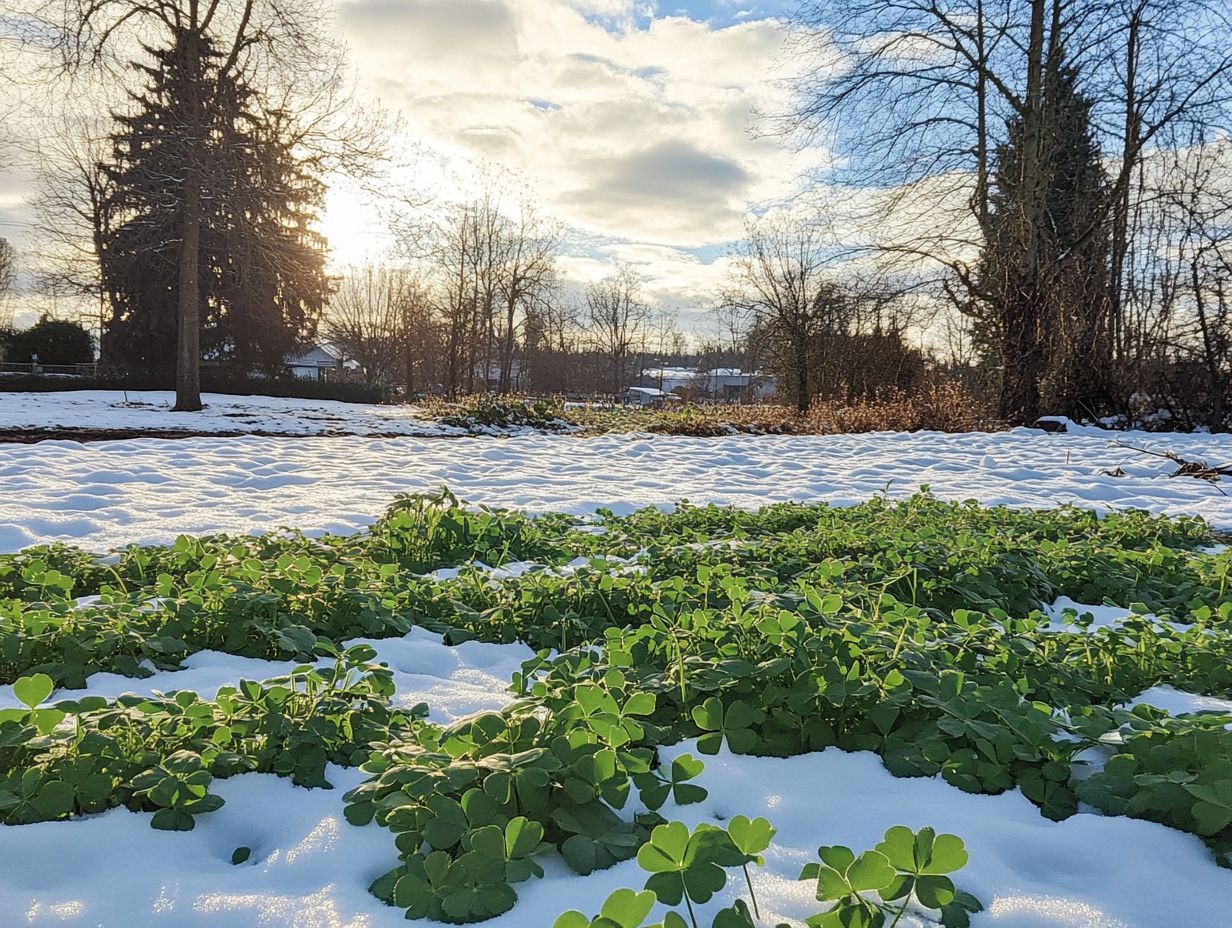
Alfalfa is known for helping improve nitrogen levels in the soil, making it a key player in enhancing soil fertility and overall garden vitality.
This remarkable plant boasts a deep rooting system that delves into the soil, allowing it to tap into nutrients and moisture from depths far below the surface, thereby bolstering drought resistance. Its roots do more than just stabilize the soil; they improve soil structure by creating channels that facilitate superior water infiltration.
When you incorporate alfalfa into your cover crop rotations, you enrich the soil with organic matter as it decomposes, infusing it with vital nutrients. This nurturing cycle boosts biodiversity and enhances the microbial ecosystem, ultimately leading to healthier plants and a significant boost in agricultural productivity.
13. Winter Triticale
Winter triticale elegantly combines the strengths of both wheat and rye, delivering outstanding cover crop benefits like enhanced soil fertility and effective erosion control in colder climates.
This hybrid grain is particularly noteworthy for its resilience, flourishing in a diverse range of soil types from sandy loams to heavier clay. This versatility makes it an exceptional choice for various agricultural endeavors.
Want the best results? Plant winter triticale in the fall for a stunning growth spurt! Regular management practices, such as monitoring moisture levels and ensuring proper spacing, can further amplify its productivity, setting you up for a bountiful and sustainable yield come spring.
14. Fava Beans
Fava beans are an exceptional choice for a nitrogen-fixing legume, significantly boosting soil fertility while offering a range of cover crop benefits, especially in cold-climate gardens.
Not only do these remarkable plants enrich the soil with vital nitrogen, but they also flourish in cooler temperatures, making them perfect for early spring planting. Their robust root systems work wonders, improving soil structure and promoting aeration and moisture retention an advantage that can greatly benefit your subsequent crops.
By incorporating fava beans into your cover crop strategy, you’ll enhance biodiversity and effectively suppress weeds, reducing your reliance on herbicides. Growing fava beans allows you to nurture healthier ecosystems and maximize yields in your garden, ultimately contributing to more sustainable agricultural practices.
15. Mustard
Mustard plants serve as exceptional cover crops, offering a multitude of benefits:
- Effective weed suppression
- Enhancement of organic matter
- Improvement of soil health
Their rapid growth cycle allows them to establish swiftly, outpacing pesky weeds and providing substantial ground cover.
By adding mustard to your garden, its biomass contributes valuable nutrients while its robust root network helps reduce erosion. When integrated into your crop rotations, mustard can disrupt pest life cycles, acting as a natural form of pest management. For optimal results, sow mustard seeds in early spring or late summer, ensuring they have ample time to flourish before winter arrives.
Incorporating mustard into your rotation not only enriches soil fertility but also fosters biodiversity, cultivating a healthier ecosystem in the process.
How to Choose the Right Cover Crop for Your Cold-Climate Garden?
Choosing the right cover crop for your cold-climate garden is essential. It enhances soil fertility and overall garden health. To learn more, explore what cover crops are suitable for cold climates while considering factors like soil type, climate conditions, and your specific gardening goals.
Understanding soil texture is crucial. If you have heavier soils, select cover crops that improve drainage. Lighter soils may benefit from plants that enhance moisture retention. Also, think about the desired benefits of your cover crops, such as erosion prevention or weed suppression.
For example, if your aim is to combat weeds while boosting nitrogen levels, legumes like clover can be an outstanding choice. If erosion control is a priority for your sloped garden, consider rye or vetch. They provide the coverage and root structure necessary to hold the soil in place effectively.
Frequently Asked Questions
What are cover crops and why are they important for cold-climate gardens?
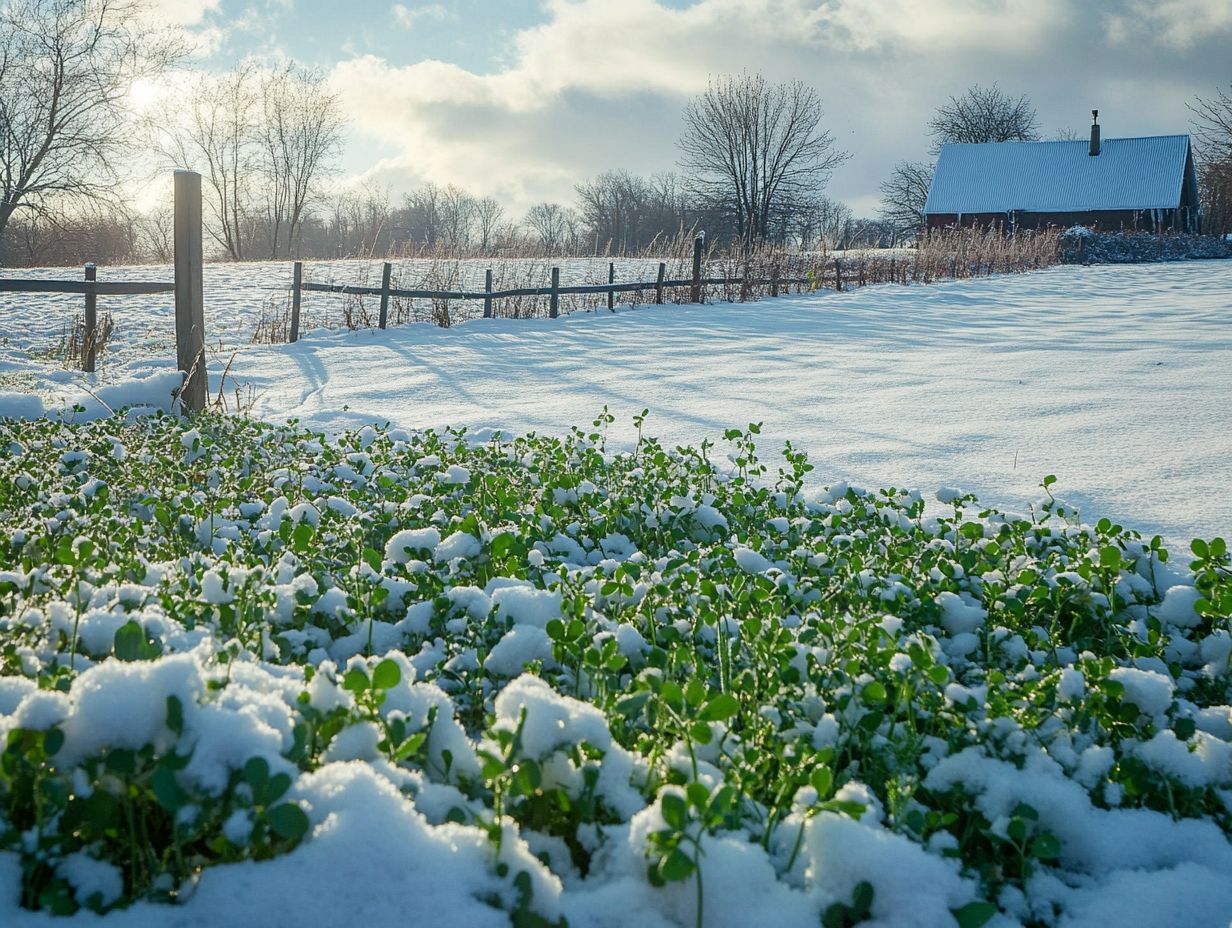
Cover crops are plants grown specifically to improve soil health and fertility. In cold-climate gardens, they protect the soil from harsh winter conditions and can provide nutrients for the next growing season, especially when paired with fertilizers that work best in cold-climate gardens.
What are the best cover crops for cold-climate gardens?
The best cover crops for cold-climate gardens include:
- winter rye
- hairy vetch
- clover
- winter wheat
These crops are hardy and can survive freezing temperatures and snow.
How do I plant cover crops in my cold-climate garden?
The best time to plant cover crops is in late summer or early fall, at least 4-6 weeks before the first frost. Broadcast seeds over the garden bed and lightly rake them in. For those in colder regions, consider using top ground covers for cold climates by planting them in rows and covering lightly with soil.
What are the benefits of using cover crops in a cold-climate garden?
Cover crops offer numerous benefits, including:
- Improving soil health
- Preventing erosion
- Suppressing weeds
- Adding organic matter to the soil
- Attracting beneficial insects
- Helping to break up compacted soil
Ready to transform your garden’s health with cover crops?
Do cover crops need to be fertilized in cold-climate gardens?
No, cover crops do not typically need fertilization. They can fix their own nitrogen from the air and return it to the soil, making them a sustainable and cost-effective way to improve soil health.
When should I terminate my cover crops in a cold-climate garden?
Terminate cover crops before they start to flower or go to seed, as this can lead to them becoming weedy. In colder climates, this is usually done in early spring before planting new crops. You can terminate them by mowing, tilling, or using a roller-crimper. Incorporate nitrogen-fixing legumes like hairy vetch and crimson clover to boost soil nitrogen content significantly.

